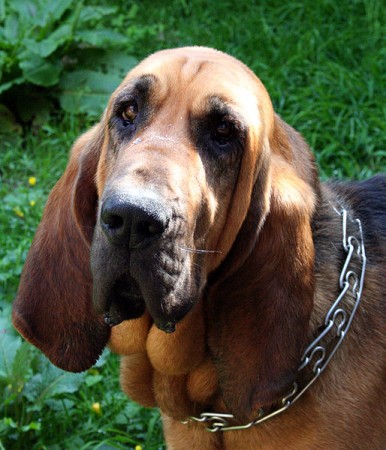 |
||
Is the Bloodhound the right breed of dog for you?The Bloodhound boasts a very long ancestry some reports dating it back as far as the third century A.D. Records show that two distinct strains, black and white, were imported in to Europe from Constantinople and developed by the monks of the St Hubert Monastery in Belgium. The Blacks were later imported in to England during the Middle Ages. The early efforts to keep the bloodlines clean gave rise to its name: meaning aristocratic, a real blueblood of dogs. Initially used in packs for hunting, the Bloodhounds' legendary scenting powers and determination to track down it's quarry no matter what, finally led to its arrival in America in the 19th century where it was quickly recruited in to the ranks of the law enforcers. Its tracking skills over long distances, and its ability to follow a scent that may be day's old, has seen them used to find escaped slaves, criminals on the run, fugitive convicts and missing persons. The American Kennel Club recognised them as breed in 1885 and classified them in to the Hound Group. These are large dogs ranging from 23 to 27 inches at the shoulder and weighing in at up to 140lbs. They're truly noble looking dogs, known for their patience and even temperament. Shorthaired and smooth coated, their coat colours are liver and tan, black and tan and red. 
This is not an everyman breed, but it could be a first time owner dog and an apartment dog, providing the new owner is ready to give her Bloodhound plenty of good off and on the lead walks. This breed is known for its stamina, so your going to need to be fit, and enjoy long walks. Training is vital for several reasons- a very important one being that you need to be able to recall him whenever he picks up on an interesting scent- untrained and your dog could be gone for hours. Another reason is they can be obstinate, and boisterous as youngsters. So puppy socialisation classes are a must-do and further obedience training is also recommended. Anyone new to the breed should stay in touch with the Breed club, where sound advice is freely given. Grooming is relatively easy- just a thorough weekly brushing should keep him in good condition. A Bloodhound requires the owner to feed 2-3 small meals a day: because these dogs are prone to bloat and similar gastrointestinal ailments. Hip dysplasia and ear and skin infections have also been reported. Unfortunately this breed is one of the most short-lived, with an average life span of just 6.75 years. If you're looking for the type of dog that will compliment your own active lifestyle that is known for its gentleness, love of family life, and its affectionate and even tempered nature. But, you also realise that he has a background that requires understanding; then perhaps the Bloodhound is the right breed of dog for you.

| ||
|
| Dog Breeds Start Page | Dog Health Start Page. |Dog Videos. |Dog Names Start Page |Puppy Training Guide | Return to Homepage Or you can .........
|
||
|
|
||